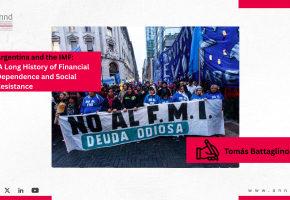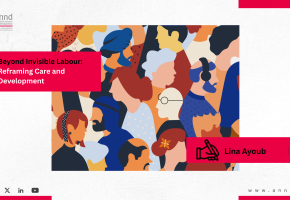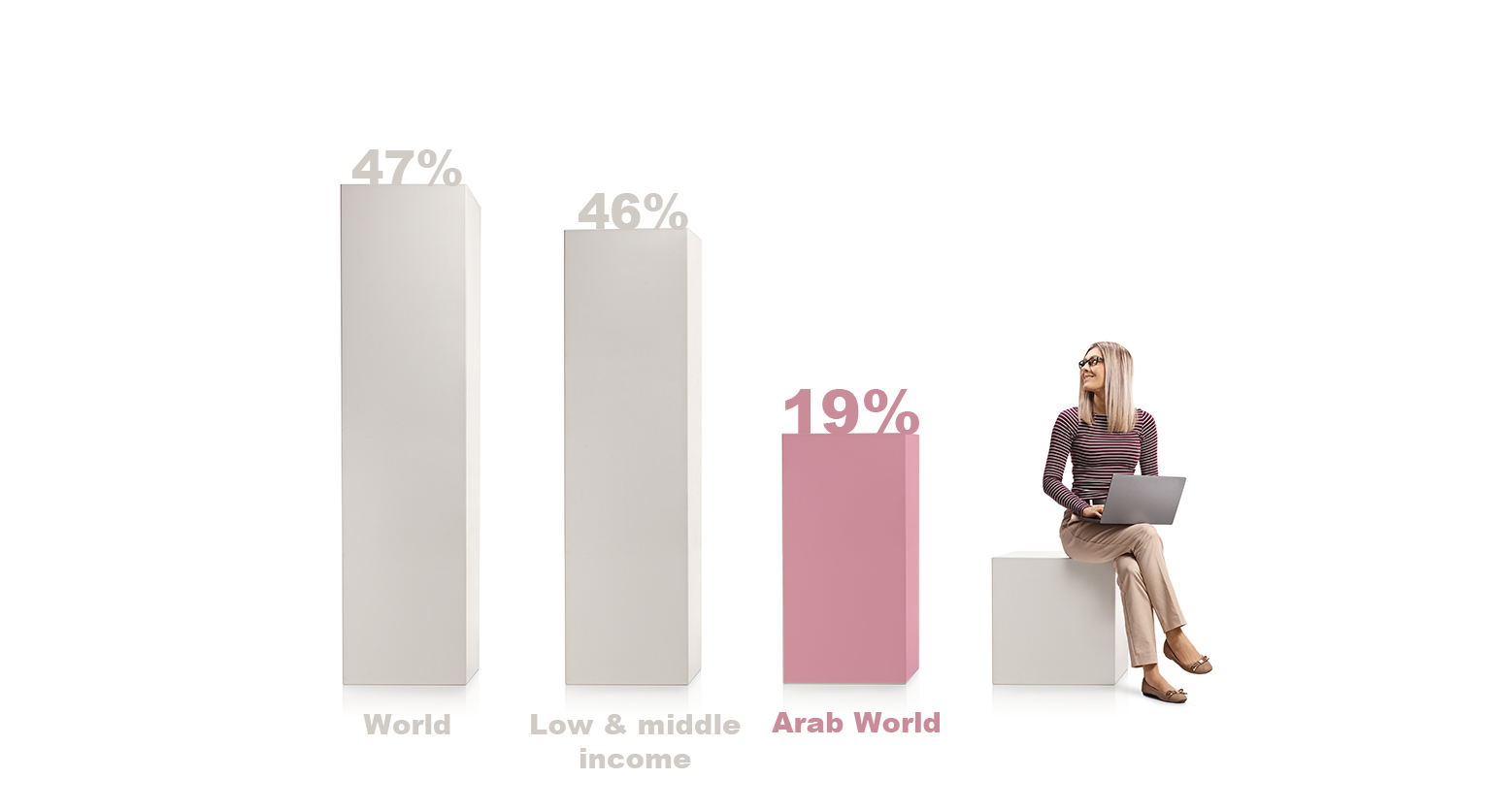
Drivers of low female labour force participation in the Arab region - Political-Economy vs Culture

Drivers of low female labour force participation in the Arab region - Political-Economy vs Culture
Rebecca Mitri
Mariam Tahsaldar
Hassan Sherry
Abstract
The reasons behind low female labour force participation in the Arab region are more political-economy related than cultural. This article argues that economic need - or the lack thereof - holds greater influence on women's participation in the workforce than socio-cultural or religious factors do.
An Overview
Women’s participation in the labour market in the Arab region is among the lowest in the world. In 2021, the female labour force participation (FLFP) rate in the region[1] stood at 19%, a staggeringly low rate in comparison to the world average of 47% and that of low- and middle-income countries, which stood at 46% (figure 1).
Figure 1: Female labour force participation rate in 2021

Source: World Development Indicators (WDI) Database.
Note: This is the labor force participation rate among females – that is, in % of female population ages 15+.
The low FLFP rate in the Arab region had persisted despite significant improvements in educational attainment among females, as figure 2 below shows.
Figure 2: Literacy rate among adult females (% of females ages 15+)

Source: World Development Indicators (WDI) Database.
Note: The literacy rate refers to the share of the population of a given age group that can read and write.
The increase in educational attainment among females in the region – that is, the substantial progress in closing the gender gap in education – has not translated into higher participation of women in the labour force. This stands as an anomaly, which is often referred to as the MENA’s “gender equality paradox”. The following question therefore arises: what are the drivers behind the low participation of females in the labour force in Arab region?
Is it Culture?
It is often argued that religion or other socio-cultural norms tend to reinforce traditional gender roles in Arab societies. The data, however, is not kind to these claims. Indonesia, for instance, is home to the largest Muslim population of any country. Likewise, Kazakhstan and Malaysia are two countries in which Islam is the dominant religion. Yet, as figure 3 shows, these three countries had some of the highest female labour force participation rates in 2021, exceeding both the world average of 47% and that of the European union, which stood at 51%.
Figure 3: Female labour force participation rate in 2021

Source: World Development Indicators (WDI) Database.
A Shrinking Public Sector?
Other explanations to the low female participation in the Arab region are sought in the context of what Assaad & Barsoum (2019) referred to as ‘Labour Market dualism’. According to this framework, women in the region are, on average, more inclined to apply for public-sector[2] jobs due to the relatively more attractive compensation schemes that they offer vis-à-vis the private sector. That is, public sector jobs in the region generally offer workplaces that are more hospitable to women, and they tend to offer as well generous childcare and education benefits, health coverage, in addition to paid leaves, and pension and retirement plans.
In Egypt, for example, public sector earnings for women were higher than private sector earnings by 60% in 1988 and 10% in 1998 (Said 2013). In Jordan, female public sector wages are approximately 17 percent higher (Ibid).
An implication of the above is that women are over-represented[3] in the public sector in Arab countries.
Figure 4: Share of women in public sector employment in selected Arab countries
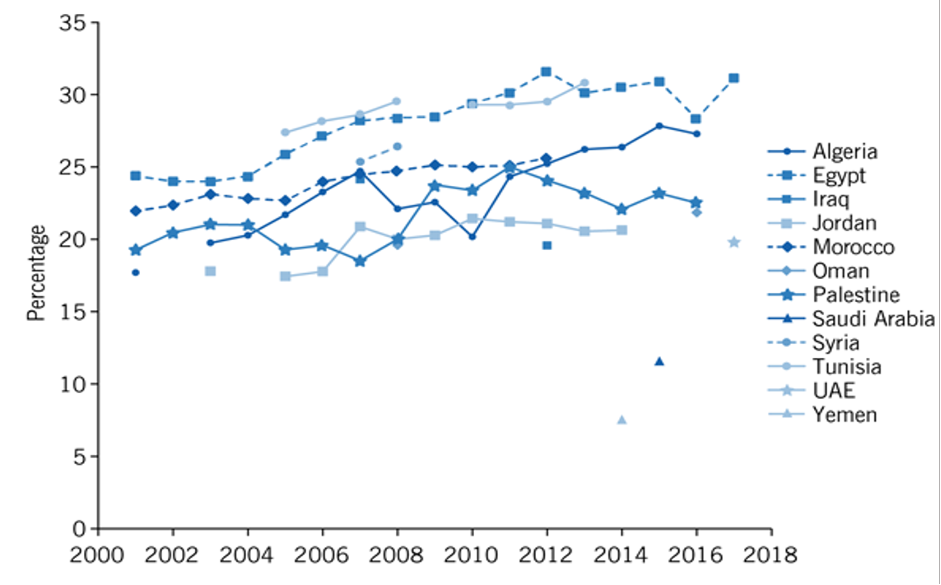
Source: Assaad & Barsoum (2019).
However, the series of economic crises arising from protracted budget deficits have dealt a serious blow to the public sector’s hiring ability. As Assaad et al. (2020) indicate, this has led to the increase in women’s unemployment.
In Egypt for instance, the increase in unemployment amongst women is often linked to the International Monetary Fund’s (IMF) stabilization programs in the country. Following the Arab uprisings, the IMF supported austerity measures that focused on cutting public spending and sharply downsizing the public sector. According to Abdo (2019), this has aggravated the poverty situation and led to a decline in women's labour force participation. As figure 5 below shows, the decrease in the female labour force participation rate in Egypt from 23% in 2016 to 16% in 2019 coincides with the IMF program in the country.
Figure 5: Female labour force participation rate in Egypt

Source: World Development Indicators (WDI) Database.
The case of Qatar also provides support to the shrinking public sector hypothesis as a cause of low participation among women in the region. Following the oil crisis of the mid-1980s and the significant decline in government revenue, public sector hiring came to a halt[4]. Nonetheless, women, particularly educated ones, were discouraged to look for other jobs in the private sector, thus dropping out of the labour force (Assaad & Barsoum, 2019).
Despite the insights that this approach adds to the understanding of labour market dynamics in the Arab region, it does not adequately capture the reason behind the low participation of uneducated women. Another approach that attempts to provide an explanation is known as the Resource Curse hypothesis.
The Curse of Natural Resources?
Historically, the Arab region (MENA region more broadly) has been defined by oil. Two important aspects of the hydrocarbons sector are its capital-intensive nature and the dominance of male employment in its operations. This can explain, to a significant degree, the historically low demand for female workers in many oil-endowed Arab countries.
In theory, oil wealth can affect the demand for, and supply of, female labour. The schematic diagram below summarizes these links (figure 6).
Figure 6: Effect of oil on female labour force participation and political influence

Source: Ross (2012, p. 118).
Government budgets in many Arab states are linked to oil income. This applies to both resource-rich Arab states, which have direct access to oil income, and to non- oil-rich states, which also benefit indirectly from oil income through exporting labour to oil-rich countries and receiving remittances in return. To buy political support, rulers have historically redistributed a large portion of oil income to citizens through government employment schemes, social programs, as well as subsidies and tax breaks. An important implication of such mode of redistribution has been the reinforcement of the male-breadwinner family type. In other words, there has been no economic need for a second source of income for families. This has deterred women from looking for work outside the household.
Another implication that follows from the dominance of the oil sector in the region is linked to the Dutch Disease phenomenon. This is an economic phenomenon which occurs when the rapid growth of one economic sector, particularly natural resources, causes a contraction in other sectors such as manufacturing or other industries that produce goods that can be traded in the international market. Generally, women are more likely to be employed in light manufacturing activities, including textiles and apparel, among others. The contraction of these industries as a result of the Dutch Disease would lead to lower female employment. According to Ross (2012), the ratio of women to males in the labour force is inversely related to the growth in the oil sector or the rise in oil prices.
This explains why oil-rich countries such as Saudi Arabia, Iraq, Libya, Qatar, Bahrain, United Arab Emirates, and Oman tend to have less women in their workforce, as the figure below reveals. Meanwhile, states with little or no oil such as Morocco, Tunisia, Lebanon and Djibouti have more women in the workforce.
Figure 7: Oil and female labor force participation in the Middle east, 1993–2002
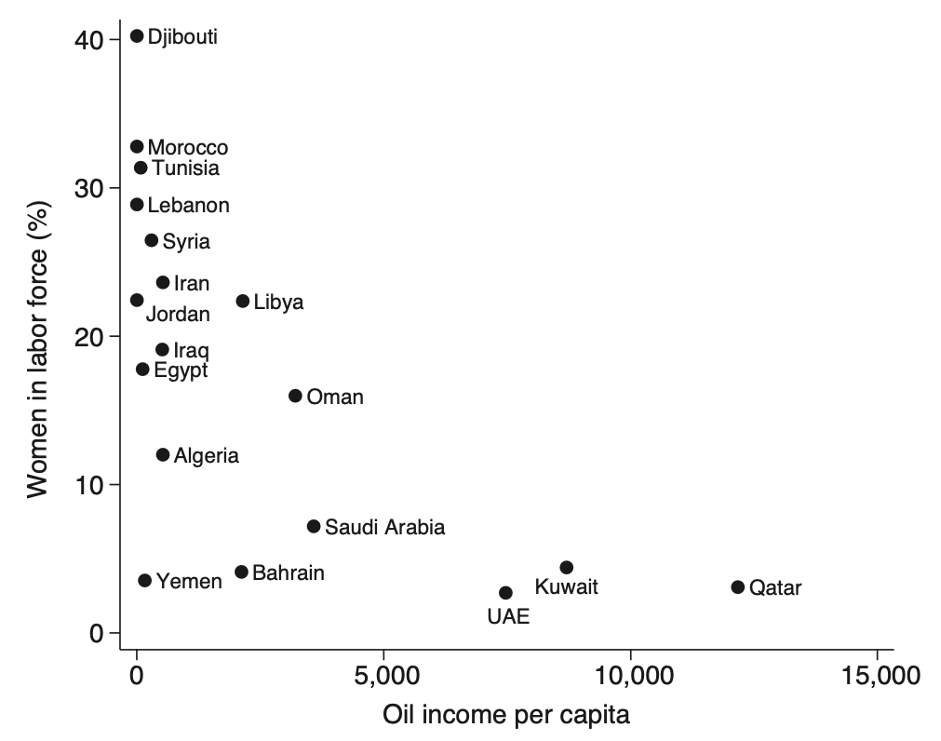
Source: Ross (2012, p. 124).
The discussion so far raises a question about the role of oil rents in prolonging the already-existing patriarchal system in the Arab region. Insofar as the hydrocarbons sector eliminates the economic need for women to join the labour force, women will be disincentivized to work since the family will be able to fulfill its economic needs. This stands in sharp contrast with Southeast Asian countries where relatively low incomes render the one-breadwinner family type inconvenient. As Karshenas (2001) indicates, the economic need Asian countries has historically given rise to new cultural norms that allow greater female labour force participation.
Concluding Remarks
As far the Arab region is concerned, political economy factors seem to hold greater influence on the participation of women in the workforce than socio-cultural or religious factors do. While this article does not negate the importance of the latter, it tries to show that the extent to which they matter depends critically on the economic conditions that exist in a country. In other words, the presence of economic need in a country is likely to determine the extent to which traditional gender roles in will be reinforced, or whether new socio-cultural norms that encourage greater female participation will be born.
If the idea is shared that higher female labour force participation rates are desired from the standpoint of equity and sustainable development, then it is imperative that Arab governments put in place policies that encourage female participation.
Rebecca Mitri
Mariam Tahsaldar
Hassan Sherry
References
Abdo, N. (2019). The Gendered Impact of IMF Policies in MENA: The case of Egypt, Jordan and Tunisia.
Assaad, R. (2014). Making sense of Arab labour markets: the enduring legacy of dualism. IZA Journal of Labour & Development, 3(1), 1-25.
Assaad, R., Barsoum, G. Public employment in the Middle East and North Africa. IZA World of Labour 2019: 463 doi: 10.15185/izawol.463
Assaad, R., Hendy, R., Lassassi, M., & Yassin, S. (2020). Explaining the MENA paradox: Rising educational attainment, yet stagnant female labour force participation. Demographic Research, 43, 817.
Karshenas, M. (1997). Economic liberalization, competitiveness and women's employment in the Middle East and North Africa. Economic Research Forum for the Arab Countries, Iran & Turkey.
Karshenas, M., & Chamlou, N. (Eds.). (2016). Women, work and welfare in the Middle East and North Africa: The role of socio-demographics, entrepreneurship and public policies. World Scientific.
Pignatti, N. (2020). Encouraging women’s labour force participation in transition countries. IZA World of Labour
Ross, M. L. (2012). The oil curse. In The Oil Curse. Princeton University Press.
Said, M. 2013. “Wage Formation and Earnings Inequality in the Jordanian Labour Market.” In The Jordanian Labour Market in the New Millennium. R. Assaad (Ed.). Oxford: Oxford University Press (forthcoming).
UN WOMEN. (2018). Understanding The Business Case for Gender Equality in The Workplace. https://promundoglobal.org/wp-content/uploads/2018/10/F-Understanding-the-Business-Case-for-Gender-Equality-in-the-Workplace.pdf
World Bank (2004), Unlocking the Employment Potential in the Middle East and North Africa: Toward a New Social Contract, Chs. 3-4, pp45-126, World Bank, Washington D.C.
World Bank, World Development Indicators. (2023). Adult female literacy rate. Available from: https://databank.worldbank.org/source/world-development-indicators
World Bank, World Development Indicators. (2023). Female labour force participation rate. Available from: https://databank.worldbank.org/source/world-development-indicators
[1] According to a study by UN Women (2018), the MENA region could have increased its GDP by $415 billion in 2017 if the gender gap in labour participation rates had been closed by only 20%.
[2] The Arab World is characterized by an oversized public sector in comparison to other developing regions. According to Assaad & Barsoum (2019), public sector employment shares are as high as 87% in Qatar, 86% in Kuwait and 72% in Saudi Arabia. Among UAE nationals, it exceeds 90% (Assaad 2014).
[3] The feminization of the public sector workforce is driven in part by the rise in educational attainment among women in the Arab region.
[4] According to Assaad & Barsoum (2019), 87% of women nationals worked in the Qatari public sector on the eve of the oil glut of the mid-1980s.
Recent publications
